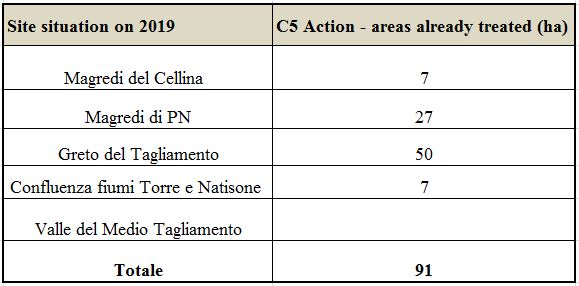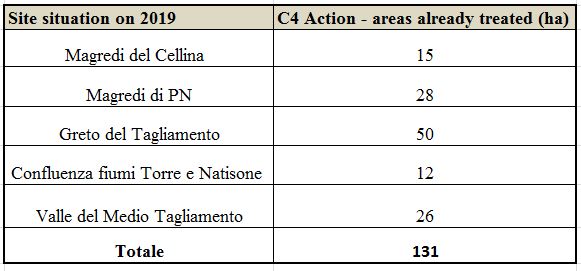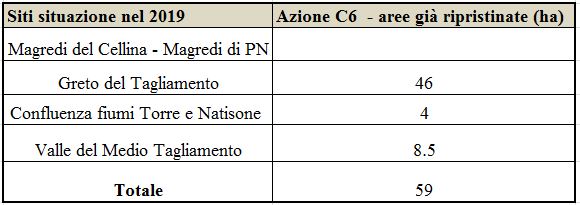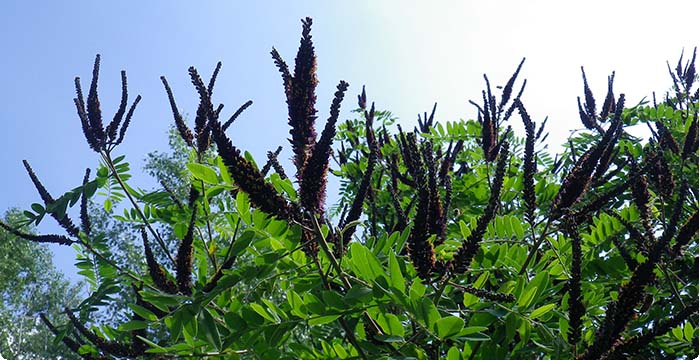PROJECT PROGRESS
GRASSLAND RESTORATION BY TRIMMING OF AMORPHA FRUTICOSA
Over 90 hectares of dry grasslands throughout the region have been restored by regaining the magredi from amorphous areas.
One must, in fact, consider that among all the threats that endanger the conservation of the magredi, the proliferation of Amorfa fruticosa, especially along the courses of the Tagliamento, Torre and Natisone rivers, is perhaps the risk factor that deserves the greatest attention on the part of the Managing Authority of the protected natural areas in question: Valle del medio Tagliamento, Greto del Tagliamento, Confluenza dei fiumi Torre e Natisone SAC.
We are dealing with a non-native species of North American origin that is particularly aggressive in alluvial areas that are characterized by a prevalence of sands and silts. This plant proliferates quickly through seeds and shoots until it completely covers the remaining dry grasslands. Furthermore, being a leguminous plant it is able to fix atmospheric nitrogen in the soil, determining its fertilization. Thanks to this characteristic it is therefore able to bring about a complete transformation of the very nature of the dry grasslands, characterized by soil that is poor in nutrients.
Since 2012, the first restoration operations carried out within this action have been carried out in the Greto del Tagliamento SAC in the Municipality of Spilimbergo.
The first phase of the operations was fundamental to understanding the real difficulties encountered in the field and to be able to improve the techniques used. In order to preserve the ecological diversity of the SACs, the amorphous plant was eliminated manually, in an almost ?surgical? manner, for the purpose of safeguarding the shrubs of native species such as Hippophae rhamnoides, Salix eleagnos, Juniperus communis, etc. After the purchase of the tractor and the necessary equipment with the funds of the LIFE Project, its elimination was then continued through the use of the forage harvester mounted on the tractor.
The higher operating costs, compared to what had initially been foreseen, due to the high level of bush encroachment with the presence of shrubs over 5 meters high and the presence of trees mixed with bushes, were offset by the possibility of entrusting some of the cutting operations to external companies interested in exploiting woody biomasses.

Evidence of Amorpha fruticosa proliferation in the "Confluenza dei fiumi Torre e Natisone". Due to the height of the specimens, over 5 meters, and to the density of the vegetation, the interventions of trimming, for the commitment of resources and expenditure of energy, although they were assigned to Action C5 have prefigured as interventions for certain ways analogous to those of the cutting of some woods (C6 action)
During 2014 and early 2015, this action was carried out in a very intense and concise manner on a large part of the Greto del Tagliamento SAC and of the Confluence of the Torre and Natisone rivers. On all the trimmed surfaces the subsequent operations continued with at least two sprout cuttings during each vegetative season.
This action is complementary to the other cutting operations (scrub clearance and felling of newly-formed trees) foreseen within the Project.
The seeds and the plants, coming from the nursery of Palazzolo dello Stella, were sown and transplanted on some of the restored surfaces.

Amorpha trimming by use of forestry mulcher and Valtra tractor (purchased with the Life Magredi Grasslands project funds), in Torre and Natisone rivers confluence

Overall, from the beginning of the project, through this action, restoration operations were undertaken on areas covered with amorphous plants, on about 50 ha in the Greto del Tagliamento SAC, about 7 ha in the Magredi del Cellina SAC near the town of Murlis in Zoppola, about 27 hectares in the Magredi di Pordenone SPA north of the Cossana, about 7 hectares in the Confluence of the Torre and Natisone Rivers SAC and 1 hectare near the Valle del Medio Tagliamento, for a total of 91 restored hectares.
PROJECT PROGRESS
For the development of this action (shrubs clearance to facilitate grasslands), it has been worked selectively and almost surgically by selecting habitats not to be treated because they could evolve towards community interest wooded formations from those where it was rather more appropriate to take action to the original grasslands restoration.
On areas with less than 20% encroachment it has worked with Regional personnel while for areas with greater encroachment the first interventions have been assigned, with no burden for the Region, to companies that use wood as a alternative energy source in the biomass plants selected on the basis of expressions of interest using an open advertisement inside the regional website.

As part of the LIFE Project, restoration by trimming and subsequent control of the shoots, through repeated shredding and mowing with biomass removal, concerned about 50 hectares in the Greto del Tagliamento SAC, about 15 hectares in the Magredi del Cellina SAC in Zoppola, about 28 hectares north of the Cossana (Maniago) in the Magredi di Pordenone SPA, about 26 hectares in the Valle del medio Tagliamento SAC , about 12 hectares in the Confluenza del Torre e Natisone SAC, for a total of 131 hectares recovered as magredi under this specific action.
Seeds were sown and seedlings transplanted in some of the areas treated that were already in an advanced state of restoration. The transplants involved seven bush areas to which 8,379 seedlings were transferred.

The various phases of grasslands restoration from encroached meadows (action C4). On some areas at the end of the trimming a kind of enrichment by blloimg distribution and transplantation of specimens from the nursery was performed

While the shrub clearing concerned abandoned grasslands characterized by the presence of more or less dense shrubs, the woods cutting took place on areas most marked by an excessive presence of neoformed trees (recent development).
The operating modes are not much different from those previously described even if for such action the commitment of forces and energies required was obviously far superior. Even in this case it was decided to entrust some of the earliest and most demanding jobs to timber-clearing operators interested in exploiting the material for biomass-power plants without charges. This mode, indirectly, constitutes an useful element to combat climate change and to encourage biodiversity because it focuses on the recovery of vanishing habitats exploiting wood as a source of renewable and alternative energy from a circularity, sustainability and environmental compatibility point of view.

Collection of timber annd woods cut (C6 action) at Greto del Tagliamento to cope with the considerable work commitment and to encourage an approach aimed at recycling of materials and at renewable energy usage, the Region has resorted to a Public advesrtisement to involve companies interested in the cutting and removal of timber to be used in biomass power plants without burden for the Region and the Project

The action, in addition to the drastic cutting operations and the removal of the biomass, has involved a whole series of successive steps such as the shredding of the stumps with the use of a forestry shredder and the subsequent substantial operations of bush clearing and cutting of the sprouts (at least two interventions were carried out during each vegetative season). Also in this case, on some of the surfaces undergoing restoration, the seeds were sown and the young native seedlings grown in the nursery of Palazzolo dello Stella were transplanted.
A large part of this action has been successfully carried out and is currently being completed on an area of around 46 hectares within the Greto del Tagliamento SAC.

Results of operations related to the C6 action in the Greto del Tagliamento SCI (before: year 2013 and after: 2016)
The graph shows the surfaces restored to grasslands divided between the three actions (bush clearing, elimination of the amorphous plant and clearing of forests) as of 30th June, 2019.










